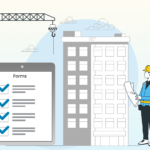With a customer-centric business approach, forms have become an integral part of various operations across organizations. From surveys to transactions, forms are used extensively to capture and manage information. As businesses begin to rely more and more on real-time data, a paper form based functioning may prove to be redundant.
Forms have existed for a significant amount of time, and now can be found everywhere in your organization. Almost 80% of all the docs scanned, printed, and processed are in some kind of paper form.

Organizations associating field operations undergo many form fillings each day. Going from one client to another, jotting down every detail about the transaction/interaction that took place is easier said than done. Not to mention, what happens when a field representative needs custom particulars for different clients? Time to print a new one!
If you are a field business manager, you know the challenges of working with a remote team. Paper-based operations demand more time, resources and energy. However, the trend is inclining towards embracing field inspection with smart mobile forms.
Use of Paper Forms in Field Services Business
In a recent survey by AIIM, it was found that to print, distribute, mail, collect, and sort, before either scanning or paper-based processing, a single document or paper form for an organization or a business costs $4.56 on average. It may not seem much initially but when the operation is on a larger scale solely depending on them, the numbers might seem to climb rapidly.
Consider 5 field employees, Using 5 forms a day, 5 days a week for the entire year, brings you roughly $6,000, and this is only 1 form per day per employee. Now consider the same 5 employees using multiple forms each day for the entire year. The $$ grows fast.
Using paper forms is likely to cost the businesses tens of thousands of dollars, possibly even more on the dependability and accountability front. Not only this, but the data collected could also turn out to be unreliable as the physical documentation of any data includes conditions that could be out of the user’s control like miscommunication, misinterpretation, climate, fatigue, etc.
Thus, relying on traditional offline forms, whether on paper or scanned, might not be the most efficient approach. In this article, we’ll delve into the reasons why using a paper form, particularly for field data collection, might not be the best choice.
Let’s take a look at some hidden costs attached to this ‘mighty’ fund-consuming, yet simple entity:
4 Major Downsides Of Using a Paper Form
Hardware Costs
Paper, scanner, printer, printer toner, and other printer hardware costs to print out forms and all associated documents to accompany the application. Also, the fax machine and the cost of faxing through it. Stationery items like files, folders, staplers and staples, paper pins, filing trays, file cabinets, shredders, etc. used to organize paper forms all add up to the cost steadily without standing out.
Processing Cost
A form received as paper may be required to be digitized before it is processed. The same adds to the man hours required to scan, index, and store the image of the original form. Not to forget, the ‘deciphering’ of some illegible handwriting. All these add up to countless productive hours wasted over re-entering the details from a document or form into a digitized system. Sometimes, forms could be lost in transit as well, resulting in labor wastage in finding, or in some cases, filling the form again as well.
Transportation and Security
Travel costs add up if the paper form needs to be picked up from or dropped somewhere. The security of these could also be quite consequential, especially, if they contain privileged or sensitive information.
Storage and Maintenance Cost
Since dealing with dynamic paper forms, one needs to have a space set up just to store the data as well. A standard 5-drawer filing cabinet costs roughly around $1,000. Assuming this type of cabinet only consumes 15 square feet of office space, the average cost of office per square foot is about $20 per square foot amounting to $300 for a filing cabinet. Adding up to this, the strict retention policies of some companies result in the purchase of more of these utilities causing them to seek off-site storage facilities opening floodgates to monthly rental charges.
Along with these costs, paper forms isolate the field data collection team from the back office teams, which are fully equipped with updated tech, and are left collecting the information with manual, out-of-date assets. This results in miscommunication, and slow response times and also provides just a little room for optimization. The digitization of this delivered data consumes a lot of time resulting in the compilation of stale data which may no longer be applicable.
For field service employees especially, digital forms have many benefits. For instance, order forms can benefit sales rep productivity significantly. Similarly, caregivers forms app offers several benefits for home healthcare providers.
Learn how you could use mobile forms to collect customized field data.
Conclusion
Paperless inspection with smart mobile forms is the way forward for field services businesses. While offline forms have been the norm for data collection, their costs and limitations are becoming increasingly evident in the modern business landscape. As organizations seek efficient, cost-effective, and secure solutions for data collection, the adoption of mobile forms and digital data capture emerges as a clear alternative.
By embracing digital tools, businesses can reduce expenses related to printing, processing, transportation, and storage, while also streamlining data entry processes and enhancing data accuracy. This transition not only minimizes financial burdens but also empowers field teams to work collaboratively with back-office personnel, resulting in improved communication, quicker response times, and data that remains relevant and actionable.
allGeo helps businesses simplify their field service operations. It helps in managing a mobile workforce by improving productivity and accountability, while reducing payroll and operations costs with solutions such as GPS tracking & time clock, Lone worker safety, Automation of field activity monitoring, Mobile forms & data collection including signature, notes, pictures, QR code, etc. The allGeo platform enables these solutions across a wide range of industries such as construction, home healthcare, facilities management and more.
Are you considering to ditch paper forms and shifting to mobile forms? Try a 14-day free trial today. No credit card required.



